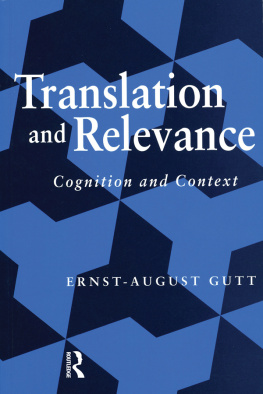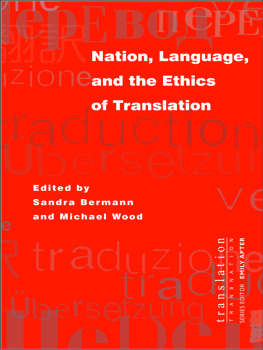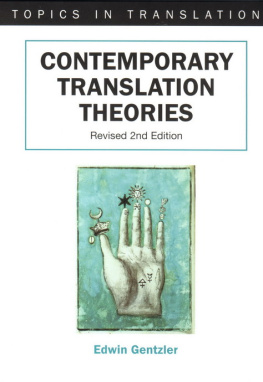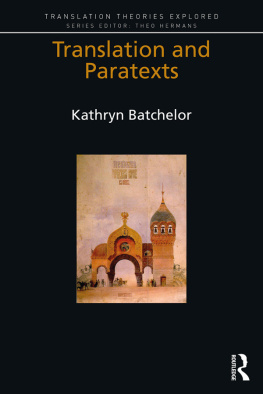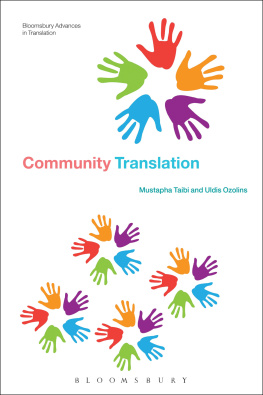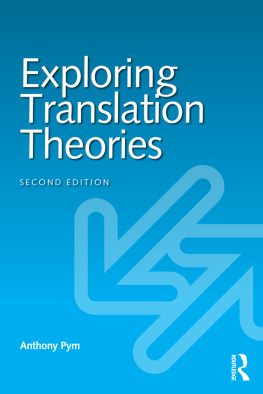Translation and Relevance
Cognition and Context
Ernst-August Gutt
First published 2000 by St. Jerome Publishing
Second edition published 2010
Published 2014 by Routledge
2 Park Square, Milton Park, Abingdon, Oxon OX14 4RN
711 Third Avenue, New York, NY 10017, USA
Routledge is an imprint of the Taylor & Francis Group, an informa business
Ernst-August Gutt 2000, 2010
All rights reserved. No part of this book may be reprinted or reproduced or utilised in any form or by any electronic, mechanical, or other means, now known or hereafter invented, including photocopying and recording, or in any information storage or retrieval system, without permission in writing from the publishers.
Notices
Knowledge and best practice in this field are constantly changing. As new research and experience broaden our understanding, changes in research methods, professional practices, or medical treatment may become necessary.
Practitioners and researchers must always rely on their own experience and knowledge in evaluating and using any information, methods, compounds, or experiments described herein. In using such information or methods they should be mindful of their own safety and the safety of others, including parties for whom they have a professional responsibility.
To the fullest extent of the law, neither the Publisher nor the authors, contributors, or editors, assume any liability for any injury and/or damage to persons or property as a matter of products liability, negligence or otherwise, or from any use or operation of any methods, products, instructions, or ideas contained in the material herein.
ISBN 13: 978-1-900650-22-9 (pbk)
Cover design by Steve Fieldhouse, Oldham, UK
Typeset by Delta Typesetters, Cairo, Egypt
British Library Cataloguing in Publication Data
A catalogue record of this book is available from the British Library
Library of Congress Cataloging in Publication Data
A catalogue record of this book is available from the Library of Congress
Contents
This study is the outcome of a growing personal concern over the theoretical foundations of translation. As a member of the Summer Institute of Linguistics (SIL), I have become closely involved with matters of translation. My linguistic work in Ethiopia under the Institute of Ethiopian Studies of the Addis Ababa University from 19761978, 19781982, and 19831987, and the attempt to deal with a trilingual situation in my own family (English, Finnish, and German) provided much practical experience in translation and its problems.
It was in 1981 that I first tried to formulate some of my concerns about the nature of the principles, rules, and methods advocated in translation and especially about their validity; much of the methodology seemed to make sense, some of it seemed questionable but the worrying thought was that it remained unclear what reality, if any, these reactions reflected and how they could be dealt with objectively. Initially I tried to express my concerns in a textlinguistic framework, but the results were not satisfactory.
During my studies for an MA degree at University College London in 198283 I was introduced by Deirdre Wilson to the relevance theory of communication, which she was developing together with Dan Sperber (cf. Sperber and Wilson 1986a). The cognitive basis of the theory combined with its concern for both comprehensiveness and explicitness appealed to me, and in the years that followed I began to apply relevance theory to a few aspects of translation (Gutt 1985, 1986, 1987,1988). The results were very encouraging, but it became quite clear that the complex nature of the issues involved required a prolonged period of concentrated research. So in 1987 I had the opportunity to return to University College London for doctoral studies under the guidance of Deirdre Wilson.
The results of my research surprised me; I had expected that relevance theory would help me to formulate a general theory of translation. However, within a year it became increasingly clear that relevance theory alone is adequate there seems to be no need for a distinct general translation theory. Accordingly, the main thrust of this study, which is a revised version of my doctoral dissertation (Gutt 1989), is to explore a range of translation phenomena and show how they can be accounted for in the relevancetheoretic framework.
Sperber and Wilson (1986a), and goes on to explore further what is generally involved when utterances are used interpretively to represent other utterances.
rounds off the discussion by showing that both the wide and the narrow view fall out naturally from the relevance-theoretic framework; it also investigates prerequisites for successful communication by translation.
After one reprint, this book was out of print for a few years. However, requests for copies kept coming, and so I was glad when St. Jerome Publishing approached me and asked for permission to re-publish the book.
Developments since the original writing of the book did not seem to warrant a major revision, so the first seven chapters are essentially the same as in the original version, except for some minor corrections and updates. The changes in relevance theory introduced by Sperber and Wilson (1995) do not affect the core of the argument in this book, but they have been commented on in the notes at appropriate points.
However, a new chapter has been added in the form of a Postscript to take up and respond to points of general interest raised in reviews and peer comments on the original publication. (For the convenience of the interested reader, the references to reviews and other peer comments of which I have become aware have been compiled in a separate listing; see the section .)
Ernst-August Gutt
October 1999
My thanks go to my colleagues at the Addis Ababa University who made it possible for my family and me to have the privilege of working and living in a linguistically and culturally rich environment. I especially thank the Silti people of Ethiopia who allowed us to live with them and to get first hand experience of both the enrichment and problems caused by cultural and linguistic diversity.
I want to express my heartfelt thanks and appreciation to Deirdre Wilson, my supervisor. It has been a great privilege and joy to work under her guidance and with her encouragement. I thank her for opening my eyes to the wonders of two of the most precious gifts we have: the human mind and the ability to share what is in it with others. My research has brought home to me in a new way the truth that we are wonderfully made (Psalm 139:14).
I thank Neil Smith for his encouragement and for his comments on the dissertation which underlies this book. I thank Regina Blass, Ron Olson, Clinton Robinson, Ronald Sim, Dan Sperber, the staff and fellow-students in the Department of Linguistics, University College London as well as other colleagues for their feedback on my research. Of course the responsibility for the shortcomings of this book is entirely my own.
I want to express my gratitude for the financial help I received from my colleagues in the Eastern Africa Group (SIL) and from the Corporation Academic Scholarship Fund (SIL) in 198788, and for the University Postgraduate Studentship which I was awarded by the University of London for 198889.
Finally, a very special thank you goes to my wife Eeva and my children Hannele, Hannu and Hedi for supporting a husband and father whose mind was not always free to give them the attention they needed. It is my pleasure to dedicate this book to them.
Next page
